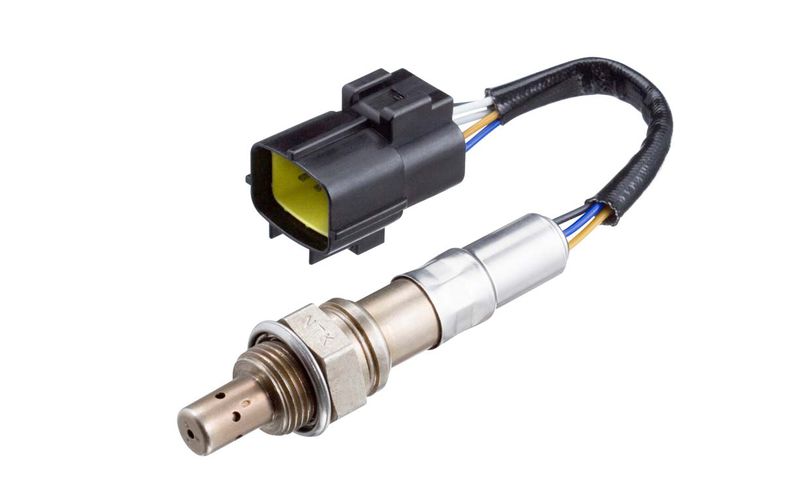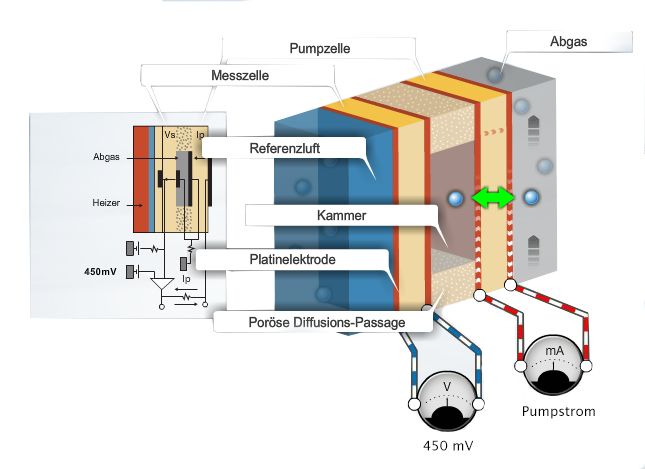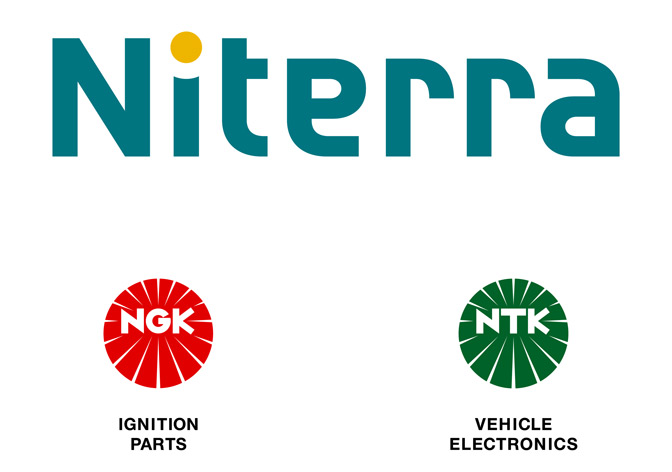Wideband sensor
The lambda sensor is an instrument used in petrol, diesel and gas engines for controlling exhaust emissions. It measures the residual oxygen content of the exhaust gas and ensures an optimum mixture composition. One type of lambda sensor is the wideband sensor.
Function
The lambda sensor is fitted in the exhaust pipe upstream or downstream of the catalytic converter  and detects the mixture composition by way of the residual oxygen content of the exhaust gas. The control unit recognises the mixture composition (lean or rich) from the lambda sensor voltage and regulates the injected fuel quantity so as to ensure an optimum mixture composition. If the mixture is rich (lambda less than 1), the control unit reduces the amount of fuel in the mixture ratio. Conversely, the amount of fuel in the mixture ratio is increased if the mixture is lean (lambda greater than 1).
The wideband sensor does not only take accurate measurements at the "stoichiometric" point where lambda equals 1, but also in the lean and rich range and is able to represent a smooth transition between different mixture states. For this reason wideband sensors are also known as "linear" lambda sensors.
This ability is required in particular for more modern engines, as these allow for lean operation over broad operating ranges, which has to be accordingly regulated.
and detects the mixture composition by way of the residual oxygen content of the exhaust gas. The control unit recognises the mixture composition (lean or rich) from the lambda sensor voltage and regulates the injected fuel quantity so as to ensure an optimum mixture composition. If the mixture is rich (lambda less than 1), the control unit reduces the amount of fuel in the mixture ratio. Conversely, the amount of fuel in the mixture ratio is increased if the mixture is lean (lambda greater than 1).
The wideband sensor does not only take accurate measurements at the "stoichiometric" point where lambda equals 1, but also in the lean and rich range and is able to represent a smooth transition between different mixture states. For this reason wideband sensors are also known as "linear" lambda sensors.
This ability is required in particular for more modern engines, as these allow for lean operation over broad operating ranges, which has to be accordingly regulated.
Mode of operation
Wideband sensors have two cells: A measurement cell and a pump cell. In the  measurement cell the oxygen content of the exhaust gas flow is compared to a set value of 450 mV. In the event of a deviation in this value, use is made of a pump current to pump oxygen ions into or out of the measurement chamber until a voltage value of 450 mV is obtained between the electrode on the reference air side and the measurement chamber electrode. This pump current is the measurement quantity which almost linearly describes the exact lambda value of the mixture. With a stoichiometric mixture it is equal to zero, as the oxygen partial pressure in the measurement chamber corresponds to the set value of 450 mV.
measurement cell the oxygen content of the exhaust gas flow is compared to a set value of 450 mV. In the event of a deviation in this value, use is made of a pump current to pump oxygen ions into or out of the measurement chamber until a voltage value of 450 mV is obtained between the electrode on the reference air side and the measurement chamber electrode. This pump current is the measurement quantity which almost linearly describes the exact lambda value of the mixture. With a stoichiometric mixture it is equal to zero, as the oxygen partial pressure in the measurement chamber corresponds to the set value of 450 mV.
Protection of the environment
Lambda sensors are indispensable for the efficient conversion of exhaust gases. More modern vehicles often employ two lambda sensors. Lambda sensors are subject to extreme loads. A properly functioning lambda sensor is a prerequisite for reliable engine operation and thus for the following three factors:
- Low fuel consumption
- Low pollutant emissions
- Correct emission values










